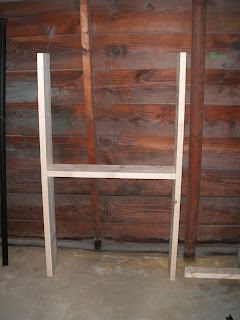 |
| Man's second best friend. |
The idea is to rout the end of the 2x8 so that is just fits the angle steel. We rout it down by the thickness of the steel so the top of the steel is flush with the top of the wood (about 1/8").
 |
| Don't do it this way |
 |
| Nicely routed |
 |
| Countersunk Lag Bolts |
 |
| A Finished H |
The steel pieces were also attached to the frame via lag bolts, albeit smaller ones, and I had to drill new holes in the steel for them. The wooden frame couldn't attach where the old cross pieces attached because we needed room for those plastic bins.I bought a nice metal drill bit and some cutting oil for this to make it easier.
Of note, Home Depot or Lowes might tell you they don't have cutting oil, but they do. They just don't keep it in the tools sections so the tools guys don't know about it. It is in the plumbing section and labeled "thread cutting oil." Get some, your metal bits and blades will thank you.
For those who are paying attention, you will note that I went to all the trouble of routing the 2x8s to accommodate the thickness of the metal, but then bolted it on with the bolts rising higher than the top of the metal. Good catch. I am figuring though, since the rivets on the old bed rose up only slightly less than the bolts do, we are probably ok. The bolts plus the metal thickness might be too much though.
So that's it, drill some holes, bolt it together, bolt the headboard on and I've got a new bed! The bed skirt covers it completely, the plastic bins fit, and there is no more motion transfer. My wife and I can sleep in the same bed again without the threat of impassioned homicide. Not bad for an unqualified guy.
 |
| The finished product. |
Have fun trying it on your own.
Qualified Schmalified,
TRW





